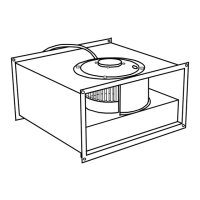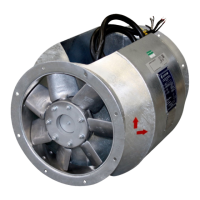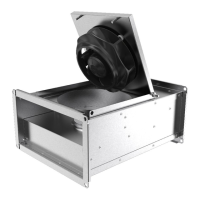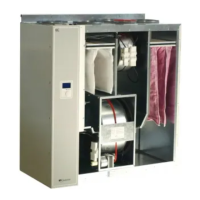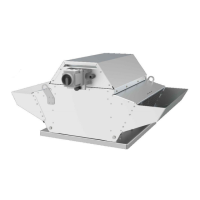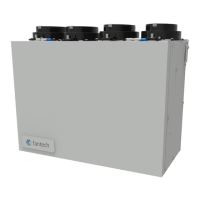5
Doument in original language
GB
Safety Information
This installation instruction is a part of the product and must
therefore be stored so that it is always available. The manufacturer
of the system or installation is responsible for ensuring that the
installation and safety instructions are compliant with the applicable
regulations.
- Fans are certified in accordance with directive
94/9/EC(ATEX).Fan category BV3 and quality level G6.3 in
accordance with ISO 14694.
- Use fans within the areas stated on the type plate of the fan (for
example Ex e IIB T3).
- Fan fulfils the requirements for zone 1 but does not separate
zones
-The fans may be used in explosive environments for transport of
gases but not to transport hot flue gases.
- Transport of solid substances, proportions of solids or mixtures of
dust/air is prohibited.
- The fans are only intended for the transport of air or potentially
explosive atmospheres in zone 1 and zone 2.
- The transported air should not corrode the fan’s casing, impeller
or motor (aluminium and steel).
- Rust particles must not be found in the air stream.
- Resonance fluctuation may occur because of installed
components; this should be checked at commissioning.
- The fans must not be installed outdoors.
Installation, electrical connections and commissioning must only be
carried out by authorised installers in accordance with the
regulations and laws applicable to electrical installations in areas
with potentially explosive atmospheres.
- Installations carried out in accordance with EN 60079-14 are
considered to meet these requirements.
- Fans must be installed and protected against any possible causes
of sparks caused by foreign objects coming into contact with the
fan blades.
- If the fan is not installed in a duct system; a protection grille
should be installed.
- No moving parts should be accessible after installation (EN ISO
13857)
- Safety equipment, i.e. safety grilles, may not be dismounted,
bypassed or disconnected.
- Regular inspections and cleaning of deposits will prevent
imbalance in the impeller. Note that the panels that hold the fans
can be relatively heavy. Ensure that they are correctly reinstalled
after inspection/cleaning and tightened to the correct torques. See
the maintenance, service and repairs section.
- Before servicing, maintenance or repair the power must be
disconnected (main circuit breaker off) and the impeller must have
stopped.
- Warning! Cleaning with a damp cloth when the fan is
connected to voltage can cause an electric shock – danger to
life!
- The fans may have sharp edges and corners, which can cause
cutting injuries.
The fan’s type plate displays the fans data at rated voltage.
-Protective earth (PE) must be connected. All fans have an external
protective earth connection (positioned on the motor).
- Electrical connections must be carried out according to the wiring
diagram in the junction box, markings on the terminal blocks or on
cable.
- When controllable fans are regulated the current can increase
with regulated voltage. Note that the power may never exceed the
rated power stated on the type plate, see table 1.
- The max. permitted operating data stated on the type plates
applies to air with a density of 1.2 kg/m
3
(1.1 – 1.39 kg/m
3
)
- Min.flow on fans, see table 1!
KTEX/DKEX:
Special conditions for safe use (1-5)
1. The fan’s rating plate displays the fan’s data at rated voltage. In
order for the fan’s permitted current and power consumption not to
be exceeded the fan may need to be pressurised with a minimum
counter pressure according to table 1.
2. PTC protective circuits in the motors must be connected to
monitoring apparatus certified according to Directive 94/9/EC that
isolates the motor from voltage supply immediately when activated.
3. When fans are installed in a duct system, the duct system must
meet enclosure classes IP20 at the inlet and IP10 at the outlet.
Components that contribute to the enclosure protection must be of
suitable material and durability.
4. Fans are only intended for fixed installation. The motors’
connection cable on KTEX is secured with cable ties in order to
guide the cable correctly in relation to the hinge on the hatch.
Attachment must be carried out so that the cable can still be
extended after fixing without the cable insulation being damaged.
5. Ambient temperature and temperature of transported air should
remain within the range – 20 to +40 °C. Fans must not be run at
flows below 200 m
3
/h at ambient temperature of 20°C. There is
otherwise a risk that the exhaust temperatures are higher than the
permitted ambient temperature.
- The motors are equipped with PTC triple protection resistors. No
more than two PTC resistor chains may be connected in series, this
can lead to undefined shut down.
- Max. test voltage for PTC resistance: 2.5 V.
- KTEX and DKEX type fans must be installed with an Ex certified
temperature monitoring unit. Checks and maintenance of the
temperature monitoring unit must be carried out according to
instructions and to a time interval that is given in the temperature
monitoring unit certificate and user instructions.
- Use of electronic or transformer based control devices is
permitted.
- Speed control using frequency inverters is not permitted.
- Current dependent protection is not permitted and must not be
used as secondary protection either.
- Motors are supplied with open drain holes.
Ex 140/180:
-
Fans must be equipped with a circuit breaker that can be
adjusted so that it protects the motor from overloading and
switches off within 15 seconds if the impeller is blocked.
- When determining the cut-out time of the motor protection, there
should be a curve that displays the motor protection cut-out time as
a function of the start current status (IA/IN) for 2.9 < IA/IN < 8 with
an ambient temperature of 20°C. The motor protection cut-out time
must not deviate more than 20 % from the cut-out curve.
- The current/power of the fans must not exceed the rated
current/rated power at rated voltage stated on the rating plate.
- The current/output values are given in table 1, by increasing the
statistical counter pressure the fan can be choked to a lower
current/output.
- The fans must not be speed controlled.
Transportation and storage
-All fans are packaged at the factory to withstand normal transport
handling.
- When handling the goods, use suitable lifting equipment in order
to avoid damage to fans and personnel.
- Avoid blows and shock loads.
- Store the fans in a dry place, protected from weather and dirt until
final installation.
- Avoid excessive storage periods (we recommend a maximum of
one year).
- Before installing the fan, check motor bearings for any noise
(carefully spin the fan by hand).
- Note! Do not lift the fans by the mains cable, connection box,
impeller or inlet cone.
Installation
Always refer to the Safety information above before
installation.
Fans are only intended for fixed installation. The installation
requires that a classification of the hazardous area has been made
according to applicable regulations (in Sweden SRVFS 2004:7
applies) and classification standards (within the EU EN 60079-10
